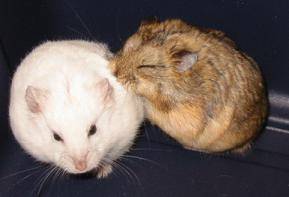The first recommendation is to wait for the female to have about 3 months to start to breed for the first time. I could do it without any problems in just 2 months of life, but it is good to wait as the female will be more mature to produce milk and support the care of the puppies.
Another very important aspect for the hamster breeding is the presentation between the male and the female.
You should never put the male in the cage of the female, since this thing vera as a threat to your home and will fight. It is the female who should get into the cage of the male.
It is still likely that female violently reject the male if not ready. We can prevent this taking together cages a few days and even hours exchange the hamster's cage so they become accustomed to the smell of the couple.
Once you have "known" we will introduce the female in the cage of the male to see how she reacts. If all goes well and the female accepts it without fights, we will leave the two together in the cage a few days (a week) and then we would return them to separate, leading again to the single female to his cage.
It is the moment to give the female a place to make the nest and provide straw or hay to winterize it.
The gestation lasted just 16 days and will have an average of 6-8 pups (may vary enough). During this period we have to let the hamster in a place where no one bother it and reduce the cleaning of the cage to the indispensable minimum. Even for 7 or 8 days of life of the young, we must let it quiet and not to touch the nest to nothing to see the hatchlings.
8 Days calves (even with closed eyes) will begin to leave the nest to explore the cage, but this should start fiddling with them.
Very soon they started eating solid food we give to the mother, so we will have to increase the amount of food that we provide.














